Blog
Understanding Diabetic Foot Ulcers

Diabetic foot ulcers are sores or wounds that can develop on the feet of people with diabetes, often due to poor circulation, nerve damage, and prolonged pressure. These ulcers commonly occur on the soles of the feet and can become severe if not treated promptly. Symptoms include pain, swelling, and sometimes a foul odor if the ulcer becomes infected. Treatment for diabetic foot ulcers focuses on wound care and managing diabetes effectively. This involves cleaning the wound regularly, using specialized dressings, and offloading pressure with customized footwear or orthotic devices. In some cases, antibiotics may be needed to treat or prevent infection. For a comprehensive evaluation and tailored treatment plan, it’s suggested you make an appointment with a podiatrist. Their expertise can significantly improve outcomes and prevent serious complications from foot ulcers.
Diabetic foot care is important in preventing foot ailments such as ulcers. If you are suffering from diabetes or have any other concerns about your feet, contact Elliot T. Udell, DPM from New York. Our doctor can provide the care you need to keep you pain-free and on your feet.
Diabetic Foot Care
Diabetes affects millions of people every year. The condition can damage blood vessels in many parts of the body, especially the feet. Because of this, taking care of your feet is essential if you have diabetes, and having a podiatrist help monitor your foot health is highly recommended.
The Importance of Caring for Your Feet
- Routinely inspect your feet for bruises or sores.
- Wear socks that fit your feet comfortably.
- Wear comfortable shoes that provide adequate support.
Patients with diabetes should have their doctor monitor their blood levels, as blood sugar levels play such a huge role in diabetic care. Monitoring these levels on a regular basis is highly advised.
It is always best to inform your healthcare professional of any concerns you may have regarding your feet, especially for diabetic patients. Early treatment and routine foot examinations are keys to maintaining proper health, especially because severe complications can arise if proper treatment is not applied.
If you have any questions please feel free to contact our office located in Hicksville, NY . We offer the newest diagnostic and treatment technologies for all your foot and ankle needs.
The Connection Between Foot Pain and Hypothyroidism
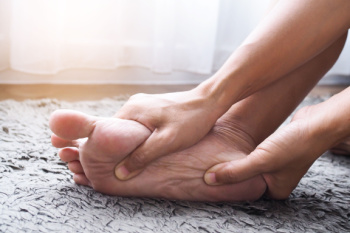
Foot pain can often be a hidden symptom of hypothyroidism, a condition where the thyroid gland does not produce enough hormones. Hypothyroidism can lead to various complications, including peripheral neuropathy and fluid retention, both of which contribute to foot discomfort. Poorly controlled thyroid levels can cause nerve damage, resulting in tingling, numbness, or pain in the feet. Additionally, hypothyroidism often leads to fluid retention, causing swelling in the feet and ankles, which can increase foot pain. The reduced metabolic rate associated with thyroid dysfunction can also affect muscle strength and joint health, further contributing to foot issues. If you have a thyroid condition and are experiencing foot pain, it is suggested that you consult a podiatrist who can treat various foot ailments, in addition to determining if it is linked to thyroid disease.
When dealing with systemic disease of the feet, it is extremely important to check the affected areas routinely so that any additional problems are caught quickly. If you have any concerns about your feet and ankles contact Elliot T. Udell, DPM from New York. Our doctor will assist you with all of your podiatric needs.
Systemic Diseases of the Feet
Systemic diseases affect the whole body, and symptoms usually are displayed in the feet. This condition can make a patient’s ability to walk unbearable. Systemic diseases include gout, diabetes mellitus, neurological disorders, and arthritis.
Gout – is caused by an excess of uric acid in the body. Common symptoms include pain, inflammation, and redness at the metatarsal/phalangeal joint of the base big toe. Gout can be treated by NSAIDs to relieve pain and inflammation, and other drugs that lower the acid levels in the body.
Diabetes mellitus – is an increase in the level of blood sugar that the body cannot counteract with its own insulin. Failure to produce enough insulin is a factor in Diabetes.
Diabetes of the Feet
Diabetic Neuropathy – may lead to damaged nerves and affect the feet through numbness and loss of sensation.
Peripheral Vascular Disease – can restrict the blood flow to the feet, and often times lead to amputation of the feet.
If you have any questions please feel free to contact our office located in Hicksville, NY . We offer the newest diagnostic and treatment technologies for all your foot and ankle needs.
Reminder: When Was the Last Time...?
Toenail Fungus Treatments
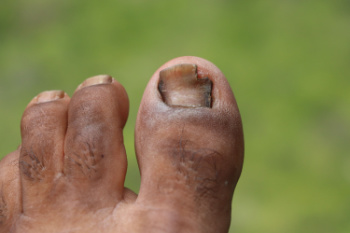
Toenail fungus, or onychomycosis, is a condition where a fungal infection leads to discoloration, thickening, and crumbling of the nail. The primary causes are fungi that thrive in warm, moist environments, such as public showers, swimming pools, and sweaty shoes. People with a weakened immune system or those who have diabetes are at higher risk. Symptoms can include toenails becoming yellow or white, thickening, and sometimes separating from the nail bed. To prevent toenail fungus, maintain good foot hygiene, keep nails clean and dry, and avoid walking barefoot in communal areas. Treatment options vary, depending on the severity of the infection. Antifungal creams and nail lacquers may be effective for mild cases. Laser treatments and nail removal are options for severe cases. For persistent toenail infections, it is suggested you schedule an appointment with a podiatrist for appropriate treatment solutions, which may include prescribed medication.
For more information about treatment, contact Elliot T. Udell, DPM of New York. Our doctor can provide the care you need to keep you pain-free and on your feet.
Toenail Fungus Treatment
Toenail fungus is a condition that affects many people and can be especially hard to get rid of. Fortunately, there are several methods to go about treating and avoiding it.
Antifungals & Deterrence
Oral antifungal medicine has been shown to be effective in many cases. It is important to consult with a podiatrist to determine the proper regiment for you, or potentially explore other options.
Applying foot powder on the feet and shoes helps keep the feet free of moisture and sweat.
Sandals or open toed shoes – Wearing these will allow air movement and help keep feet dry. They also expose your feet to light, which fungus cannot tolerate. Socks with moisture wicking material also help as well.
If you have any questions please feel free to contact our office located in Hicksville, NY . We offer the newest diagnostic tools and technology to treat your foot and ankle needs.
What to Do About Toe Pain

Toe pain is discomfort or soreness in one or more toes, commonly resulting from various conditions. Frequent causes can include injuries such as sprains or fractures, arthritis, bunions, hammertoes, and ingrown toenails. Toe pain can also arise from wearing tight or improperly fitting shoes, which can lead to blisters, calluses, and corns. For mild cases, resting the foot, wearing comfortable shoes, and taking pain medication may help to alleviate symptoms. For more severe pain, orthotic devices, prescribed medications, and in some cases, surgery might be needed. If you have persistent or severe toe pain, it is suggested that you visit a podiatrist, who can provide a proper diagnosis and treatment plan.
Toe pain can disrupt your daily activities. If you have any concerns, contact Elliot T. Udell, DPM of New York. Our doctor can provide the care you need to keep you pain-free and on your feet.
What Causes Toe Pain?
Most severe toe pain is caused due to a sports injury, trauma from dropping something heavy on the toe, or bumping into something rigid. Other problems can develop over time for various reasons.
Toe pain can be caused by one or more ailments. The most common include:
- Trauma
- Sports injury
- Wearing shoes that are too tight
- Arthritis
- Gout
- Corns and calluses
- Hammertoe
- Bunions
- Blisters
- Ingrown toenails
- Sprains
- Fractures (broken bones)
- Dislocations
When to See a Podiatrist
- Severe pain
- Persistent pain that lasts more than a week
- Signs of infection
- Continued swelling
- Pain that prevents walking
Diagnosis
In many cases the cause of toe pain is obvious, but in others, a podiatrist may want to use more advanced methods to determine the problem. These can range from simple visual inspections and sensation tests to X-rays and MRI scans. Prior medical history, family medical history, and any recent physical traumatic events will all be taken into consideration for a proper diagnosis.
Treatment
Treatments for toe pain and injuries vary and may include shoe inserts, padding, taping, medicines, injections, and in some cases, surgery. If you believe that you have broken a toe, please see a podiatrist as soon as possible.
If you have any questions please feel free to contact our office located in Hicksville, NY . We offer the newest diagnostic tools and technology to treat your foot and ankle needs.
How Foot Bones Work Together in Ballet

In ballet, the coordination of foot bones is essential for achieving fluid and graceful movements. During a tendu, the foot extends and stretches, with the bones and tendons working together to create a smooth, elongated line. A plié involves bending the knees while keeping the feet firmly grounded, requiring precise articulation of the ankle and foot bones to maintain balance and control. Port-de-bras, the movement of the arms in coordination with the feet, enhances overall fluidity and expression. Effective foot and ankle articulation involves strengthening the muscles and tendons surrounding these areas to ensure flexibility and stability. Proper technique and consistent practice help ballet dancers achieve aesthetic, elegant movements and avoid injury through careful, controlled use of the foot bones and surrounding structures. If you are a ballet dancer, and have injured your foot or ankle, it is suggested that you consult a podiatrist who can provide treatment and guide you on how to perform specific stretches for optimal results.
If you have any concerns about your feet, contact Elliot T. Udell, DPM from New York. Our doctor can provide the care you need to keep you pain-free and on your feet.
Biomechanics in Podiatry
Podiatric biomechanics is a particular sector of specialty podiatry with licensed practitioners who are trained to diagnose and treat conditions affecting the foot, ankle and lower leg. Biomechanics deals with the forces that act against the body, causing an interference with the biological structures. It focuses on the movement of the ankle, the foot and the forces that interact with them.
A History of Biomechanics
- Biomechanics dates back to the BC era in Egypt where evidence of professional foot care has been recorded.
- In 1974, biomechanics gained a higher profile from the studies of Merton Root, who claimed that by changing or controlling the forces between the ankle and the foot, corrections or conditions could be implemented to gain strength and coordination in the area.
Modern technological improvements are based on past theories and therapeutic processes that provide a better understanding of podiatric concepts for biomechanics. Computers can provide accurate information about the forces and patterns of the feet and lower legs.
Understanding biomechanics of the feet can help improve and eliminate pain, stopping further stress to the foot.
If you have any questions please feel free to contact our office located in Hicksville, NY . We offer the newest diagnostic and treatment technologies for all your foot and ankle needs.
Foot Pain Relief From Prolonged Standing
 Working on your feet all day can lead to significant foot pain, but there are several strategies to alleviate discomfort. Start by wearing supportive, well-fitted shoes with good arch support and cushioning to reduce strain on your feet. Custom orthotic inserts can provide additional support tailored to your foot's unique shape. Take regular breaks to sit down and rest your feet, even if it is just for a few minutes. Stretching exercises, such as calf stretches and toe flexes, can improve flexibility and reduce muscle tension. Incorporate foot massages and rolling your feet over a tennis ball to relieve pressure points and enhance circulation. Maintaining a healthy weight can reduce the stress on your feet. At the end of the day, elevate your feet to decrease swelling. If foot pain persists, it is suggested that you consult a podiatrist for a thorough evaluation and personalized treatment plan for more tips and to address any underlying issues.
Working on your feet all day can lead to significant foot pain, but there are several strategies to alleviate discomfort. Start by wearing supportive, well-fitted shoes with good arch support and cushioning to reduce strain on your feet. Custom orthotic inserts can provide additional support tailored to your foot's unique shape. Take regular breaks to sit down and rest your feet, even if it is just for a few minutes. Stretching exercises, such as calf stretches and toe flexes, can improve flexibility and reduce muscle tension. Incorporate foot massages and rolling your feet over a tennis ball to relieve pressure points and enhance circulation. Maintaining a healthy weight can reduce the stress on your feet. At the end of the day, elevate your feet to decrease swelling. If foot pain persists, it is suggested that you consult a podiatrist for a thorough evaluation and personalized treatment plan for more tips and to address any underlying issues.
While working on the feet, it is important to take the proper care of them. For more information about working on your feet, contact Elliot T. Udell, DPM from New York. Our doctor will treat your foot and ankle needs.
Working on Your Feet
Standing on your feet for long periods of time can cause stress and pain in your feet. Your whole body may experience change in terms of posture, back pain, bunions, callouses and or plantar warts. There are ways to avoid these conditions with proper foot care, smart choices and correct posture.
Positive Changes
Negative heeled shoe – Choosing this shoe type places the heel slightly lower than the ball of the foot. These are great for overall foot health. Find shoes that fit you correctly.
Go barefoot – Our feet were not designed to be enclosed for all hours of the day. Try to periodically expose your feet to air.
Eliminate Pain
Foot Exercises – Performing simple exercises, incorporating yoga and doing stretches are beneficial. This will allow increased blood flow to the area and muscles of the foot.
Achilles tendon – Stretching the foot out flat on the floor will relax the calf muscles and tendon. These exercises can be performed almost anywhere. Make sure you add these exercises to your daily regimen.
With a little bit of this information and knowing more about foot health, you will notice changes. Foot stretches and proper footwear will help with pain and prevent further issues.
If you have any questions please feel free to contact our office located in Hicksville, NY . We offer the newest diagnostic and treatment technologies for all your foot and ankle needs.
Why Live with Pain and Numbness in Your Feet?
Peripheral Neuropathy Affects the Feet

Peripheral neuropathy, which arises from damaged or diseased peripheral nerves, significantly impacts the feet by disrupting the transmission of signals from the brain. Symptoms of peripheral neuropathy can include numbness, tingling, sharp pain, and muscle weakness in the feet. Such symptoms can make everyday activities challenging, and may cause balance issues or foot injuries that are unnoticed due to loss of sensation. The underlying causes of peripheral neuropathy are diverse, with diabetes being a prevalent factor. An early diagnosis and treatment of peripheral neuropathy is vital to manage symptoms and prevent further nerve damage. A podiatrist can perform a thorough exam and order diagnostic tests to develop a comprehensive treatment plan for you. This may include medication or lifestyle modifications to alleviate discomfort and improve mobility. If you have peripheral neuropathy that affects your feet, it is suggested that you schedule an appointment with a podiatrist for an exam and treatment.
Neuropathy
Neuropathy can be a potentially serious condition, especially if it is left undiagnosed. If you have any concerns that you may be experiencing nerve loss in your feet, consult with Elliot T. Udell, DPM from New York. Our doctor will assess your condition and provide you with quality foot and ankle treatment for neuropathy.
What Is Neuropathy?
Neuropathy is a condition that leads to damage to the nerves in the body. Peripheral neuropathy, or neuropathy that affects your peripheral nervous system, usually occurs in the feet. Neuropathy can be triggered by a number of different causes. Such causes include diabetes, infections, cancers, disorders, and toxic substances.
Symptoms of Neuropathy Include:
- Numbness
- Sensation loss
- Prickling and tingling sensations
- Throbbing, freezing, burning pains
- Muscle weakness
Those with diabetes are at serious risk due to being unable to feel an ulcer on their feet. Diabetics usually also suffer from poor blood circulation. This can lead to the wound not healing, infections occurring, and the limb may have to be amputated.
Treatment
To treat neuropathy in the foot, podiatrists will first diagnose the cause of the neuropathy. Figuring out the underlying cause of the neuropathy will allow the podiatrist to prescribe the best treatment, whether it be caused by diabetes, toxic substance exposure, infection, etc. If the nerve has not died, then it’s possible that sensation may be able to return to the foot.
Pain medication may be issued for pain. Electrical nerve stimulation can be used to stimulate nerves. If the neuropathy is caused from pressure on the nerves, then surgery may be necessary.
If you have any questions, please feel free to contact our office located in Hicksville, NY . We offer the newest diagnostic and treatment technologies for all your foot care needs.
Risks for and Causes of Ankle Sprains in Volleyball
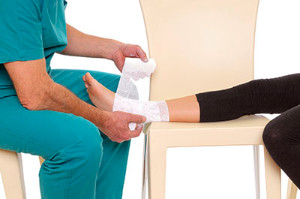
Ankle sprains are a frequent injury in volleyball, often resulting from various risk factors and causes. The sport’s fast-paced nature involves quick lateral movements, jumps, and landings, which can easily lead to rolled or twisted ankles. Uneven landings after jumps are a primary cause, especially when players descend on another’s foot. Inadequate warm-ups and poor ankle strength increase the risk, as muscles and ligaments are less prepared for sudden movements. Playing on an uneven or slippery surface can also contribute to instability and potential sprains. Additionally, wearing inappropriate footwear that lacks proper support or traction further heightens the risk. If you have endured a sprained ankle while playing volleyball, it is suggested that you contact a podiatrist who can effectively treat this condition.
Sports related foot and ankle injuries require proper treatment before players can go back to their regular routines. For more information, contact Elliot T. Udell, DPM of New York. Our doctor can provide the care you need to keep you pain-free and on your feet.
Sports Related Foot and Ankle Injuries
Foot and ankle injuries are a common occurrence when it comes to athletes of any sport. While many athletes dismiss the initial aches and pains, the truth is that ignoring potential foot and ankle injuries can lead to serious problems. As athletes continue to place pressure and strain the area further, a mild injury can turn into something as serious as a rupture and may lead to a permanent disability. There are many factors that contribute to sports related foot and ankle injuries, which include failure to warm up properly, not providing support or wearing bad footwear. Common injuries and conditions athletes face, including:
- Plantar Fasciitis
- Plantar Fasciosis
- Achilles Tendinitis
- Achilles Tendon Rupture
- Ankle Sprains
Sports related injuries are commonly treated using the RICE method. This includes rest, applying ice to the injured area, compression and elevating the ankle. More serious sprains and injuries may require surgery, which could include arthroscopic and reconstructive surgery. Rehabilitation and therapy may also be required in order to get any recovering athlete to become fully functional again. Any unusual aches and pains an athlete sustains must be evaluated by a licensed, reputable medical professional.
If you have any questions please feel free to contact our office located in Hicksville, NY . We offer the newest diagnostic and treatment technologies for all your foot and ankle needs.
More...
Causes and Risk Factors for Foot Stress Fractures

Stress fractures, common to runners and other athletes, result in placing excessive strain on the foot bones. One significant cause of stress fractures is a sudden increase in physical activity, whether it involves frequency, duration, or intensity. Transitioning from soft surfaces such as indoor tracks to harder ones like sidewalks can stress the bones of the feet. Improper technique due to foot conditions like blisters or bunions can also contribute by altering the foot's natural movement patterns and redistributing weight unevenly. Footwear that is poorly fitting, worn-out, or lacking proper support significantly increases the risk of stress fractures. While athletes commonly experience these injuries, non-athletes are also susceptible from extended walking on uneven terrain during vacations. Other risk factors for foot stress fractures, including osteoporosis, which reduces bone density and strength, as well as low vitamin D levels. Female athletes face other risks, possibly due to biomechanical differences, hormonal factors, and nutritional deficiencies. If you are experiencing pain in your foot after activity, it is suggested that you schedule an appointment with a podiatrist for appropriate testing and treatment options.
Activities where too much pressure is put on the feet can cause stress fractures. To learn more, contact Elliot T. Udell, DPM from New York. Our doctor can provide the care you need to keep your pain free and on your feet.
Dealing with Stress Fractures of the Foot and Ankle
Stress fractures occur in the foot and ankle when muscles in these areas weaken from too much or too little use. The feet and ankles then lose support when walking or running from the impact of the ground. Since there is no protection, the bones receive the full impact of each step. Stress on the feet can cause cracks to form in the bones, thus creating stress fractures.
What Are Stress Fractures?
Stress fractures occur frequently in individuals whose daily activities cause great impact on the feet and ankles. Stress factors are most common among:
- Runners
- People affected with Osteoporosis
- Tennis or basketball players
- Gymnasts
- High impact workouts
Symptoms
Pain from the fractures occur in the area of the fractures and can be constant or intermittent. It will often cause sharp or dull pain with swelling and tenderness. Engaging in any kind of activity which involves high impact will aggravate pain.
If you have any questions please feel free to contact our office located in Hicksville, NY . We offer the newest diagnostic and treatment technologies for all your foot and ankle needs.
Diabetes and Foot Wound Healing
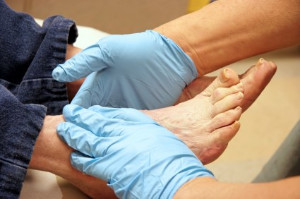 Diabetes significantly impacts wound healing, particularly in the feet, due to high blood sugar levels that impair circulation and immune response. Diabetes is a chronic condition where the body cannot regulate blood sugar properly, leading to various complications. In diabetics, poor blood circulation reduces the delivery of oxygen and nutrients essential for healing, while neuropathy, or nerve damage, diminishes the sensation, making it harder to notice injuries. As a result, even minor foot wounds can progress to serious ulcers or infections if left untreated. Foot wounds in diabetic patients often occur due to friction, pressure, or minor trauma, exacerbated by poorly fitting shoes or neglect. To prevent and treat these wounds, maintain proper foot hygiene, inspect feet daily for injuries, and manage blood sugar levels rigorously. Wearing well-fitted shoes and avoiding walking barefoot can also help prevent injuries. If you have diabetes and have persistent wounds or complications, it is strongly suggested that you consult a podiatrist. These healthcare providers specialize in diabetic foot care, providing tailored treatment and preventing severe outcomes.
Diabetes significantly impacts wound healing, particularly in the feet, due to high blood sugar levels that impair circulation and immune response. Diabetes is a chronic condition where the body cannot regulate blood sugar properly, leading to various complications. In diabetics, poor blood circulation reduces the delivery of oxygen and nutrients essential for healing, while neuropathy, or nerve damage, diminishes the sensation, making it harder to notice injuries. As a result, even minor foot wounds can progress to serious ulcers or infections if left untreated. Foot wounds in diabetic patients often occur due to friction, pressure, or minor trauma, exacerbated by poorly fitting shoes or neglect. To prevent and treat these wounds, maintain proper foot hygiene, inspect feet daily for injuries, and manage blood sugar levels rigorously. Wearing well-fitted shoes and avoiding walking barefoot can also help prevent injuries. If you have diabetes and have persistent wounds or complications, it is strongly suggested that you consult a podiatrist. These healthcare providers specialize in diabetic foot care, providing tailored treatment and preventing severe outcomes.
Diabetic foot care is important in preventing foot ailments such as ulcers. If you are suffering from diabetes or have any other concerns about your feet, contact Elliot T. Udell, DPM from New York. Our doctor can provide the care you need to keep you pain-free and on your feet.
Diabetic Foot Care
Diabetes affects millions of people every year. The condition can damage blood vessels in many parts of the body, especially the feet. Because of this, taking care of your feet is essential if you have diabetes, and having a podiatrist help monitor your foot health is highly recommended.
The Importance of Caring for Your Feet
- Routinely inspect your feet for bruises or sores.
- Wear socks that fit your feet comfortably.
- Wear comfortable shoes that provide adequate support.
Patients with diabetes should have their doctor monitor their blood levels, as blood sugar levels play such a huge role in diabetic care. Monitoring these levels on a regular basis is highly advised.
It is always best to inform your healthcare professional of any concerns you may have regarding your feet, especially for diabetic patients. Early treatment and routine foot examinations are keys to maintaining proper health, especially because severe complications can arise if proper treatment is not applied.
If you have any questions please feel free to contact our office located in Hicksville, NY . We offer the newest diagnostic and treatment technologies for all your foot and ankle needs.
Various Congenital Foot Conditions
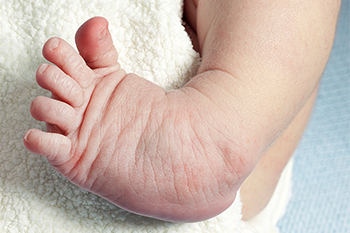
Congenital foot problems encompass a range of conditions that affect foot development from birth. Clubfoot is characterized by inwardly turned feet and twisted ankles, often requiring corrective casting or surgery early in infancy. Larsen syndrome involves multiple joint abnormalities, including clubfoot, and requires comprehensive manipulation. Metatarsus adductus causes the front part of the foot to turn inward, usually resolving with stretching exercises or corrective shoes. Metatarsus varus results in a curved appearance of the foot bones, treated similarly to metatarsus adductus. These conditions can impact mobility and foot alignment if left untreated, potentially leading to discomfort and difficulties in walking. Early diagnosis and intervention are essential for addressing congenital foot problems, often involving a combination of specific techniques to promote proper foot development and functionality from infancy through childhood. If your child has been born with a congenital foot condition, it is strongly suggested that you have a podiatrist on your healthcare team who can guide you to an effective treatment strategy.
Congenital foot problems require immediate attention to avoid future complications. If you have any concerns, contact Elliot T. Udell, DPM of New York. Our doctor can provide the care you need to keep you pain-free and on your feet.
Congenital foot problems are deformities affecting the feet, toes, and/or ankles that children are born with. Some of these conditions have a genetic cause while others just happen. Some specific foot ailments that children may be born with include clubfeet, polydactyly/macrodactyly, and cleft foot. There are several other foot anomalies that can occur congenitally. What all of these conditions have in common is that a child may experience difficulty walking or performing everyday activities, as well as trouble finding footwear that fits their foot deformity. Some of these conditions are more serious than others. Consulting with a podiatrist as early as possible will help in properly diagnosing a child’s foot condition while getting the necessary treatment underway.
What are Causes of Congenital Foot Problem?
A congenital foot problem is one that happens to a child at birth. These conditions can be caused by a genetic predisposition, developmental or positional abnormalities during gestation, or with no known cause.
What are Symptoms of Congenital Foot Problems?
Symptoms vary by the congenital condition. Symptoms may consist of the following:
- Clubfoot, where tendons are shortened, bones are shaped differently, and the Achilles tendon is tight, causing the foot to point in and down. It is also possible for the soles of the feet to face each other.
- Polydactyly, which usually consists of a nubbin or small lump of tissue without a bone, a toe that is partially formed but has no joints, or an extra toe.
- Vertical talus, where the talus bone forms in the wrong position causing other bones in the foot to line up improperly, the front of the foot to point up, and the bottom of the foot to stiffen, with no arch, and to curve out.
- Tarsal coalition, when there is an abnormal connection of two or more bones in the foot leading to severe, rigid flatfoot.
- Cleft foot, where there are missing toes, a V-shaped cleft, and other anatomical differences.
- Macrodactyly, when the toes are abnormally large due to overgrowth of the underlying bone or soft tissue.
Treatment and Prevention
While there is nothing one can do to prevent congenital foot problems, raising awareness and receiving neonatal screenings are important. Early detection by taking your child to a podiatrist leads to the best outcome possible.
If you have any questions please feel free to contact our office located in Hicksville, NY . We offer the newest diagnostic tools and technology to treat your foot and ankle needs.



